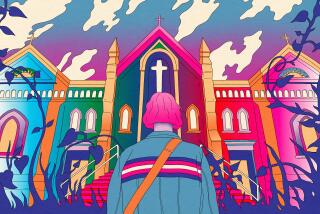Ex-Mormons Say Breaking Up Was Hard to Do
- Share via
For Tom Hall, 77, the disillusionment came during the 1970s when the Mormon Church wouldn’t allow blacks to become priests.
Carma Naylor, 64, says she began doubting the religion in which she had been raised after debating the meaning of the Bible with a Jewish friend who had been born again.
And William Ken Andersen, 23, said he left the Church of Jesus Christ of Latter-day Saints six months ago because of problems with “church leaders ignoring opposing facts about dogma and trying to cover them up.”
All three are now active members of Ex-Mormons for Jesus, a California-based group whose Information and Visitors Center in Orange, organizers say, is the state’s only facility of its kind.
The group’s beliefs:
* That Mormons aren’t true Christians;
* that they follow false doctrines that preclude them from entering heaven;
* that leaving Mormonism is a profoundly difficult and isolating experience requiring the support of fellow ex-Mormons.
None of which is true, says Tom Thorkelson, director of interfaith relations for the church’s Orange County Public Affairs Council.
“First,” he said, “as a Latter-day Saint, I believe in and accept Jesus Christ as my savior. We are Christians, though we recognize that there are some theological differences.”
As for the alleged pressure on those who leave, Thorkelson said, it is no greater than that exerted by a member of any faith “who has deeply held convictions and finds somebody who shared those convictions leaving them and joining a counter group. I’ve seen lots of people whose families disowned them because they became members of the Mormon faith.”
Founded in 1830 by Joseph Smith, a young man from Palmyra, N.Y., who said God spoke to him in a vision, the Mormon Church considers itself the “restored” church of Jesus Christ, which it believes was altered after the deaths of the original apostles.
Drawing on both the Bible and the Book of Mormon, the fast-growing church has more than 12 million members worldwide. The church’s message clearly resonates with some. Church officials say the denomination experienced a growth rate, from 1984 to 2000, of 52% per decade.
Along the way, the institution has shed some of its more controversial practices, including polygamy, which was banned in 1890, and barring blacks from the priesthood.
Nonetheless, gathering in a donated church social hall on Chapman Avenue, Ex-Mormons for Jesus holds monthly support meetings for those “coming out” of Mormonism. The group also operates the information and visitor center, which is open six days a week in a small storefront featuring anti-Mormon tracts and books on Mormon theology and history. Director Charlotte Pardee, 76, is on hand to encourage Mormons leaving their faith.
She says she doesn’t know how many members the group has in California or around the country.
“Our purpose,” said Pardee, who has never been a Mormon, “is to help Christians understand Mormonism and to give Mormons a place to come when they start doubting their faith. I’ve shed more tears over Mormon souls than I did over my husband’s, before he was saved.”
Her argument with Mormonism, Pardee says, began 42 years ago when two Mormon missionaries came to her door.
“They told me that my Presbyterian baptism was no good,” she recalls, still bristling at the memory. “They said that the Mormon Church was the only true church in the world.”
It was the beginning of a conversation she has continued ever since and a moment that defined her life, propelling her to become headquarters director of the California organization that is part of a loose-knit movement of ex-Mormons nationwide.
About 20 people, including both ex-Mormons and evangelical Christians, attended the Orange County group’s recent monthly meeting featuring, among other things, a lecture by Naylor, who said her leaving Mormonism after 40 years nearly tore her family apart.
“When I first realized that Joseph Smith had changed the word of God,” Naylor said, “I thought I felt the presence of demonic spirits. I was frightened, alone and paralyzed with fear. That gives you an idea of the power of fear in the church to never turn away.”
Rene Ellison, 46, said her leaving the church more than two decades ago caused her first marriage to break up.
“My family still tries to bring me back,” Ellison said. Attending support meetings, she said, lets her hear “other people’s stories that are the same stories as mine. I always thought there was something wrong with me.”
For Karla Gledhill, 40, the meetings have provided a new perspective.
“Mormons tend to cast ex-Mormons as being satanic,” said Gledhill, who left the church at age 19 because of a “creepy feeling” she got at the temple.
“They never let up,” she said. “They still have the literature sent to me, and I get harassing phone calls. This group makes me stronger and gives me ammunition to stand up for what I truly believe.”
The meeting ended with an open prayer, during which one member asked God to “turn the hearts of the Mormon elders ... turn that church around, Lord.”
Such talk doesn’t faze Thorkelson of the church’s Orange County Public Affairs Council.
“I invite anybody to examine the lives of friends and neighbors who are practicing Latter-day Saints to see if they are striving to lead lives consistent with the teachings of Jesus Christ,” he said. “Rather than denigrate other faith traditions, we prefer to build relationships and let our lives speak for themselves.”
More to Read
Sign up for Essential California
The most important California stories and recommendations in your inbox every morning.
You may occasionally receive promotional content from the Los Angeles Times.










